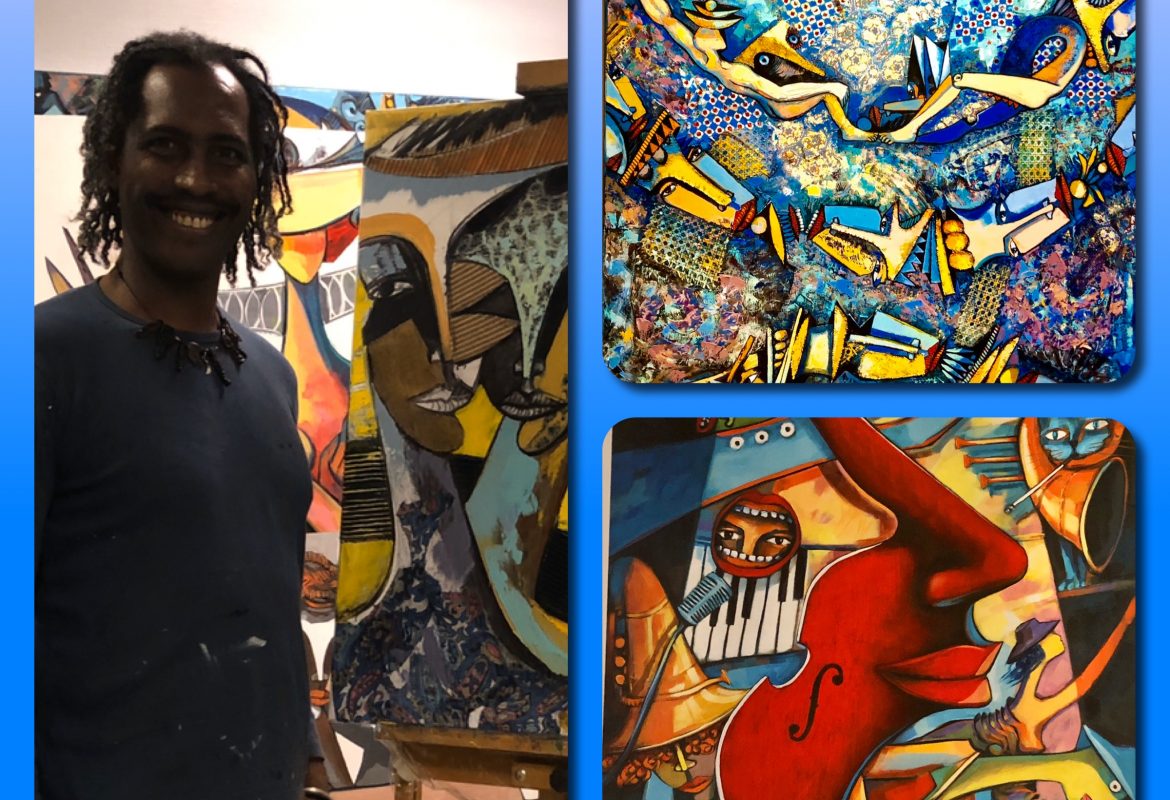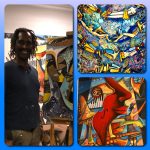Become Better Acquainted With The Exciting Artist, Ramon Eduardo Haiti Filiu
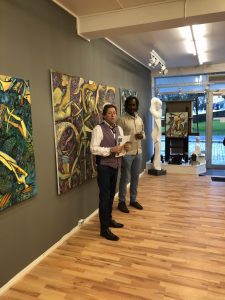
Egill Wendelboe Aarø and Ramon Haiti Filiu at the opening of the exhibition
At a cultural gathering in Bergen, the city between seven mountains in Norway, an exhibition of works by Ramon Eduardo Haiti Filiu opens at the Wendelboe Gallery.
I have been aware of this artist for some years now and on this particular evening I am accompanied by a colleague who is acquainted with both Ramon and his excellent helper, Norunn Kalgraff. I am presented to both of them.
It is a full house and while the colorful exciting works of art blend with Cuban musical rhythms to form the framework for the evening, I make an appointment with the artist to visit his studio.
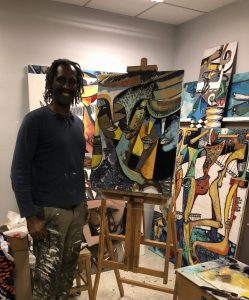
Ramon Haiti Filiu in his studio
A few weeks later I find myself in the studio at Damsgårdsveien 127 along with the artist himself, Norunn Kalgraff who takes care of administration, and Willy Rasmussen, who originally brought the artist to Norway and who will act as interpreter when needed.
For me, the area around Damsgårdsveien and Laksevåg is familiar, but walking into Ramon Haiti Filiu's studio is as if entering a new world. The paintings immediately exude positive vibrations and the atmosphere is warm and relaxed, more so because of the people who are present.
I open the conversation by asking Ramon to tell me a little about his background and why he became an artist. It turns out that Ramon Haiti comes from an artistic family. His mother, Mercedes Filiu, was a seamstress and made costumes during his upbringing, and his father, Ramon Haiti, was a renowned sculptor. That Ramon Haiti Filiu should become an artist was hardly surprising, since art was in his genes from both his maternal side and his paternal side. In addition to his father's name, the artist has his mother's last name, as is the custom in Cuba. During his childhood, Ramon spent a great deal of time in his father's workshop where he was able to try out his creative abilities, mainly so that his father could have peace to work, he adds with a smile. His father, who passed away in 2007, became one of his most important teachers during his later development as an artist. His mother is still alive.
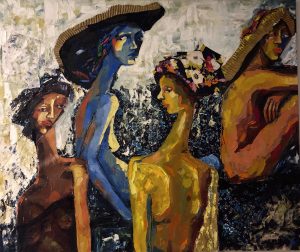
One of the early paintings by Ramon Haiti Filiu
Ramon Haiti Filiu showed at an early age what a talented artist he actually is and in 1984, at only thirteen years of age, he graduated from the Paulita Concepción art school in Havana. For a long time he practiced both sculpture and painting but in the end he had to make a choice before continuing his further education. He asked his father for advice, but his father wanted his son to make his own decision. When asked by the undersigned whether it was a difficult choice, the artist laughs slightly before answering ”No, it was not very difficult.” He did not want to have to compete with his exceptionally talented father.
After four years at the San Alejandro Academy of Fine Arts in Havana (1992-1996), Haiti took a bronze smelting course at the Havana College of Art. Having all the education he could glean from his father and the college in his baggage, moving forward his task was to discover his own expression. He studied other artists in expressionism, impressionism and fauvism. Color especially interested him, because in the Caribbean, the light and the colors are so powerful that he sensed that he ought to work in that area. Today it is often the powerful colors that one notices when first discovering Haitis´ art. His expression consists of so much more than that, however. This is something we will return to.
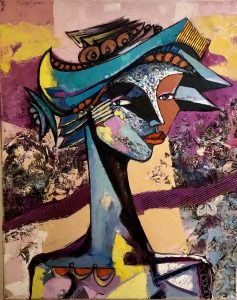
SJØLVSIKKER (ASSERTIVE) not difficult to find associations with both Picasso and Matisse.
When I ask whether or not Henri Matisse (1869-1954) was one of his role models, the artist answers in the affirmative. Matisse is often regarded as the father of Fauvism with all his colorful images. Many Norwegian painters of the period were also influenced by him. Several of them, like Axel Revold and Per Krohg, also attended Matisse's school of painting in Paris. What one refers to as Fauvism in France, in other parts of the world is referred to as expressionism, for example Germany, where artists such as Emil Nolde (1867-1956) are to be found. However, there was a great similarity, mainly because of the use of primary colors, red, yellow and blue but also green, even though it is a secondary color. It is because of its powerfulness that it is often compared to the primary colors. The fact that Ramon Haiti Filiu has been impressed by the use of color in these movements is not difficult to understand when viewing his art.
The impressionists, on the other hand, are known for their use of light, something that also preoccupies Haiti. Think of Claude Monet, (1840-1926) and August Renoir, (1841-1919). Some of their pictures are pure studies in light and in addition, their intention was to capture the moment, causing the composition to seem random, like a kind of snapshot of the day, but random they were not. For the artist, it was probably the study of light that has been his greatest inspiration, for Ramon Haiti´s paintings do not give the impression of random composition.
The artist spent a long time figuring out which themes and not least what construction to choose and today his images appear employing powerful colors, without being typically expressionist, fauvist or impressionist for that matter. No, the paintings by Ramon Haiti Filiu are very special, the artist having found his own unique expression. That he also has a background in sculpture may be seen in the elements that the artist adds to his pictures. We always find corrugated cardboard, colorfully patterned fabrics and straw, or ”jute” as Haiti calls it. We also find inspiration from his father in the paintings, not least in some of the forms.
The themes of his art works are global. Ramon Haiti talks about how Cuba is the one Latin American country that stands out from all the others, most certainly when it comes to religion. Most countries in Latin America are influenced by Catholicism, but Cuba has a religion called Santeria. It is a religion composed of several religions, in other words it is a syncretic religion, so called in professional theological language. It is influenced by a fusion of the African religion that came with the slaves, not least the Yoruba religion of Nigeria and the Catholicism that characterized Cuba at that time. In addition, it is laced with a portion of mysticism, more specifically the spiritism of Allan Kardec who is considered to be the originator of the spiritist movement.
In a recent conversation with Willy Rasmussen, mentioned earlier and who is regarded as an expert on this religion, I heard how that in Santeria the saints are similar to the saints of Catholicism, something that can also be seen as a fusion of the two religions. Rasmussen also told me that he was present in Cuba in connection with the papal visit in the late 1980s, but in this piece we will not discuss the religion itself, just refer to it as one of the backdrops for Ramon Haiti Filiu's expression.
Haiti also began to read philosophy and became increasingly concerned with what we humans choose to include in our lives. Family and friends were used as sources. He began to look at people looking at themselves, the choices they make in life and to ask the question why. This applies to both the positive and the negative choices we make. As we know, according to both causality, cause and effect, as well as the consequence ethic, all choices made in life lead to some result. Perhaps, by studying the choices that humans make and why exactly those choices are made, as Haiti does, perhaps one may, in some cases, become free to make better choices in the future.
The artist goes on to say that with these elements as part of his own cultural filter, it has characterized his art in that his expressions are not dedicated to one particular religion, race or culture, for that matter. Although the content is often characterized by the spiritual, it is not as an expression of a specific religion. Although people are to be discovered in the pictures of Ramon Haiti, there are no portraits of people, nor are they portrayed as specific individuals or set in relation to religion, culture or the expression of anything philosophical. Whatever we, the viewers, discover in his art is something completely different. We can relate to religion, philosophy and specific individuals if we wish, but then it is about the artist's non-intentionality and the cultural filter of the viewer.
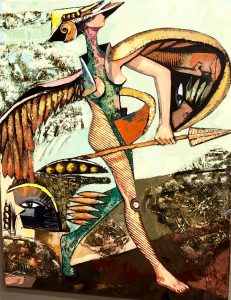
ENGELEN MED TRYGGE STEG. (THE ANGEL WITH SECURE STEPS) That Ramon Haiti views the woman as strong and independent is confirmed by this painting.
As far as religion is concerned, Haiti believes religion to be something that people have invented in addition to being written by men. If we think of the Catholicism that is also part of Santeria, we may agree. Why is it that only gospels written by men have been placed in the Biblical canon and how many women do we find in the old testament, for example? Admittedly, we find the book of Ruth there, but, as grandmother to King David she is more important in Judaism than in Catholicism. Sarah is another, but only as the wife of Abraham and the mother of Isaac. Not only that of course, but you understand what the undersigned means, "The woman as the other sex". If we go to The New Testament, we find the Virgin Mary, but her importance is in being the mother of Jesus. Mary Magdalene, for example, was most likely a much more important person in reality than she was portrayed as being in the Bible. Regardless of whether or not one agrees with the artist that religion is something that people have invented, one can at least agree that the Bible clearly bears the influence of having been written by men.
Ramon Haiti Filiu is further concerned with the freedom of the individual. One should make independent choices and not be influenced by either politics or religion. There is much existentialism in this statement in which the influences of both Simone De Beauvoir and Jean-Paul Sartre are clear and so we move into the philosophical. According to Haiti, the interpersonal is most important. Where you live or where you come from is not the most important aspect but will always be part of the individual's cultural filter.
Haiti also attempts to portray many aspects of his own culture in his images. When asked what we can see of the artist's own culture in the pictures, Haiti replies that Cuban culture is very complex as it is a mixture of many cultures. Cuba is very different from Mexico and Peru, because Cubans have their own religion, Santeria, as we have already mentioned. Christianity is not prominent in Cuba as it is in other countries such as Peru and Mexico which are Catholic. Cuba also has many freedoms that the Catholic countries have banned, such as abortion and divorce. Communication and interaction between people is important, but the artist is uncertain whether or not this is specific to Cuba and Latin America. Nonetheless, Ramon Haiti Filiu tries to portray each individual in the context of their circumstances and there is always an elastic quality to the images that is both Cuban and Latin American, according to the artist himself.
Also, nature is not a landscape in the usual sense in Haiti's paintings, the figurative was discarded in the process of finding his unique expression.
The Road To Norway
Willy Rasmussen, who has previously been mentioned and who acted as interpreter during my visit to the studio, has known Ramon Haiti Filiu since he was 17 years old. Rasmussen´s background is from the Spanish faculty at the University of Bergen and as he continued on to business school, he worked, on a scholarship, to make a plan for an economical and political developmental model based on Latin American countries. Willy Rasmussen first visited Havana in 1988 and in 1989 he met Ramon Haiti Filiu for the first time through a family he knew in the city.
Many years later, more specifically in 2006, ”Latin American Days In Bodø” was to be arranged and Rasmussen was asked if he knew of any Latin American artists that he could recommend. He suggested Ramon Haiti Filiu whom he had followed for all the years since he became acquainted with him in 1989 and assured them that Ramon was a skilled, exciting artist. There was an exhibition at the SAS hotel and in addition to the exhibition, Haiti also taught at the Bodø School of Art. The exhibition was incredibly successful and all the paintings were sold, quite a feat and something that most artists can only dream of. It testifies as to how unique Haiti's images actually are and not least, how skilled he is. No wonder they wanted him to return and in the summer of that year there was another exhibition, this time at Galleri Sjøgaten in Bodø. This time as well, most of his works were sold.
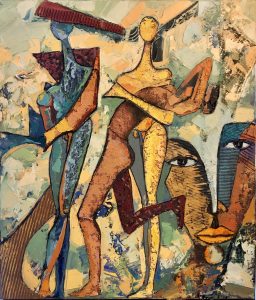
BRÅ KONTAKT (SUDDEN CONTACT), Is this about the transition from Cuba to Norway?
There were several more trips to Norway and in 2009 the artist made the leap from the warm, colorful, bustling metropolitan life in Havana and moved to the bleakness of the cold north. Haiti himself says that it was a huge contrast to come to Norway but that he has evolved immensely as an artist since he made the move. He says that in Cuba one does not have the same relationship with nature that one has in Norway and that communication between the individual and nature was new to him. Nature is now more prominent in his images, but only symbolically, not naturalistically. The artist uses geometric shapes and he does not paint mountains but rather more air and water, basic elements from antiquity.
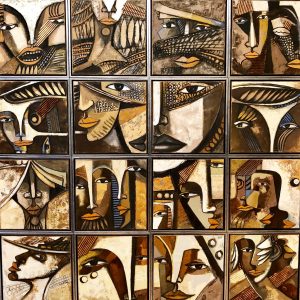
INSTALLASJON 16 BILDER (INSTALLATION 16 PICTURES). Not difficult to make associations with African masks here. The color scheme also calls to Africa, does it not?
The undersigned makes the comment that many artists, such as Picasso and Braque, also believed that the basic elements of nature were geometrical and the artist replies that it was not only they, but also the Africans who believed so. We move on to the subject of the African masks that both Picasso, Braque and others were concerned with for some years. Just consider Picasso's ”Girls from Avignon” (1907). It is quite clear that the shape of the prostituted women's faces is inspired by African masks. In Ramon Haiti's pictures we also find similar facial forms and in addition to the artist drawing on cubism, we also find organic forms that soften the whole. Another element found in Haiti's pictures and which he himself points out is the long neck. The colorful people in the pictures may also call out to African roots and not just a little. While African culture was a quest for something authentic and original in the case of Picasso and Braque, it is an intrinsic part of Ramon Haiti's culture and therein lies the major difference that causes Haiti's African influence to feel more authentic to the undersigned and perhaps to others as well ?
In the same way that Ramon Haiti is concerned that his paintings should not be linked to religion or politics, as we have previously discussed, the people in the pictures should not be associated with any particular race or gender for that matter. The soft faces may mirror the feminine and the harsher ones may symbolize the masculine, but they often blend into one another. The women are often masculine because the artist believes that women have previously held powerful positions in society, something not reflected in history as was mentioned earlier with regard to the bible.
THE ART
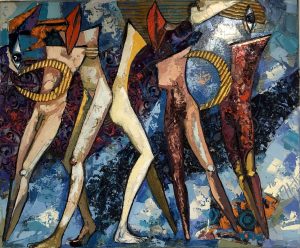
STØTTAR (SUPPORTS)
Støttar (Supports)
As mentioned earlier, Ramon Haiti Filiu´s art is both colorful and unique. Looking at the picture ”Supports”, the legs are the first things to catch the eye. All together we find five pairs of legs, some facing each other while others are opposite. This image is available in several versions and during the visit to the studio the idea behind these images was explained to me. The title ”Støttar” (Supports) has several meanings, among other things, that architecture in Cuba is characterized by columns that "support" the buildings. As mentioned earlier, the artist is preoccupied with the interpersonal and in Cuban culture people support each other, they are there for each other in both good and difficult times, be it family but also friends and neighbors and so on. Neighbors become family in Cuba. Perhaps we have something to learn from Cubans?
Ramon Haiti's images are collages and are what we refer to as mixed media. While some are painted in oil, others are painted in acrylic thus creating varying possibilities during the process, both in terms of drying time and suppleness of the paint. It is not, however, always easy to see what type of paint has been used when viewing the final result. As mentioned previously, we will also, without fail, find corrugated cardboard and colorful pieces of fabric and straw (”jute” as the artist says). Composition and color schemes are carefully planned. The artist creates many sketches and then paints some of them. The textiles are carefully included in the planning and help to decide the color palette. In this picture, the main color is blue, a cold color that often recedes. However, the warm colors are included, such as the legs at the far right of the image. Thus, they form a contrast. Here we also find a piece of clothing and considering what his mother worked with, this may be interpreted as a tribute to her. The corrugated cardboard is also present, organic shapes, to the left and right of the image. One acts as a link between the two pairs on the right of the image. While the corrugated cardboard is an organic form, the legs are more cubist in shape, creating a fresh contrast in the image. If we let our gaze wander back to the corrugated cardboard, it is easy to make associations to the new moon in the shape on the right while the one on the left of the picture is more ring-like. The New Moon may symbolize something new, the road ahead after the unity and support given by the shape of the corrugated cardboard on the left. The yellow color may be a symbol of the sun that gives life and energy and given the Cuban culture, it can stand out as a symbol of how Cubans get on with things, thanks to the "supports".
There is much more to be gleaned from the contemplation of this painting as there is in all the other works by Haiti, but that must be up to you, in the role of viewer, to discover.
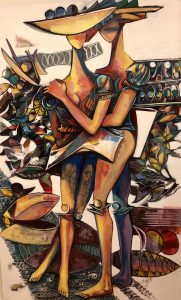
VED DIN SIDE (BY YOUR SIDE)
Ved din side (By your side)
Another image that reflects cohesion is ”By Your Side”. The picture is painted in acrylic on a recycled plastic sheet. This means that despite the image being 200 cm by 125 cm, it weighs very little. There is something practical and indeed environmental about this choice.
We see two people holding each other in the center of the picture. Are there two women, one woman and one man, or is it otherwise? We remember that the artist does not define gender in the person, in other words these are more or less androgynous individuals we find here. Both characters have a shape on their head that could possibly be a hat but it might just as well be interpreted as a boat or a fruit platter, if you so choose. The choice determines whether one has just embarked, is already on a journey or has the opportunity to acquire something fruitful. Perhaps by merging the last two there is a fruitful journey to embark on?
Since the title of the painting is ”By Your Side”, is it perhaps the beginning of a romantic relationship or is it simply a new friendship we witness in this picture?
As in all paintings by Haiti, there are various interpretations that may be put onto the pictures. Just go hunting, take your time. What one discovers is entirely up to the viewer and depends on the person's cultural filter and, not least, the life lived. As the undersigned has repeated many times in previous posts, art is about communication. Just as in any other form of communication, an extra effort is sometimes required from the viewer but when that is the case, one really does have an unforgettable experience.
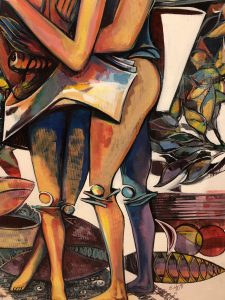
BY YOUR SIDE detail
Focusing again on ”By Your Side” we can say that it is an extremely aesthetic painting, both in composition and the selection of color as well as the light. Despite the fact that the people are abstract, we find surprising details, such as the kneecaps. They are clearly meant to stand out but not in the way Rembrandt would have done, they are more decorative than biological, thus emphasizing the aesthetic.
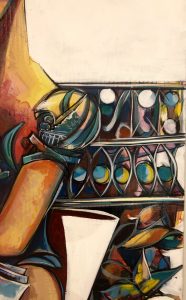
BY YOUR SIDE detail.
Moving our eyes up a little and to the right, we find a row that can easily cause the mind to wander to one of the metopes of the Parthenon Temple in Athens. We do not, however, find any centaurs or other figures from Greek mythology and so the mind moves on. There is a detailed, strictly constructed pattern in which the colors are clearly matched. Many might make associations with jewelry or the third eye. As I said, there is much to discover in Haiti´s art.

En dag i Stavanger (One day in Stavanger) Photo Norunn Kalgraff
The Visual Diary
Artists often carry a drawing pad and some colors when on the move, others often write a diary, but what does Ramon Eduardo Haiti Filiu do? He combines these two forms of expression and paints his diary. A good example is the picture ”One Day in Stavanger”. The picture is based on an afternoon when he was about to have an exhibition at Galleri Amare in Stavanger and as he had some time to spare, he wandered around the city, going to Cafe Sting, eating fish, chatting with the people he met and so on. Such episodes create both an exciting and aesthetic diary, at least in the case of Ramon Haiti.
Night Jazz and The Musical Sisters
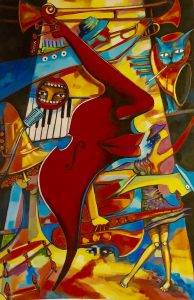
Night Jazz - picture for poster
We previously mentioned how Haiti plans his paintings thoroughly and this picture is no exception, except for one detail, the large eye-catching red shape in the middle of the image that is both an instrument, a mouth, a nose, where the back of the nose also takes the form of a calf and a foot with a high heel, while the shape of the foot also coincides with the shape of the instrument. Here the artist captures in one form everything that happens at a jazz festival, the music, the song, the senses and not least, the dance. It was therefore important that the form to be captured in the picture stood out from the rest. The artist says that in the process of creating the painting, he made associations to the film, The Red Violin or ”Le Violon Rouge” as it is called in French. The movie is from 1998 and is about the story of a mysterious red violin and its many owners. Just as the violin made its mark on its various owners, jazz music also makes its mark on all those who experience it. Not surprisingly, it was this very painting that made such a strong impression on the undersigned that it also became a portal into the artistic world of Ramon Eduardo Haiti Filiu.
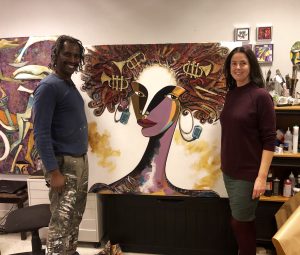
Ramon Haiti Filiu and Norunn Kalgraff in front of the latest version of DE MUSIKALSKE SØSTRE (THE MUSICAL SISTERS)
As a continuation of the night jazz scene, ”The Musical Sisters” was born. This is a form of female images where we find musical instruments in the hair. They are all different but they have the musical instruments in common. So far, this group of siblings consists of four sisters, but more will be added according to the artist. In the picture we see the latest addition to the siblings. Together in the picture with Haiti is his former wife, Norunn Kalgraff. They have now gone their separate ways but remain good friends. Kalgraff still takes care of all the administration regarding Haiti´s art-work, as previously mentioned.
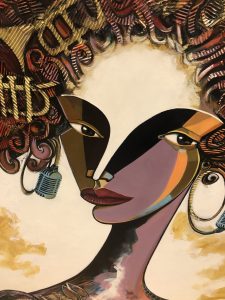
THE MUSICAL SISTER. A section
Currently, family is taking care of the sisters, the undersigned saw Kalgraff's version but as the sibling group is expanded, there will probably be more people who wish to take part in this series of musical sisters. These are very aesthetic images where the shape is clearly defined and the color selection is harmonious. At the same time, they are slightly ”tough”, something that has proven to appeal to youth. Notice the expression! This is no "forgive me for existing" type female that we meet here, so we return to the artist's view of the woman as a powerful being. Simone De Beauvoir probably would have liked to have this painting on her wall.
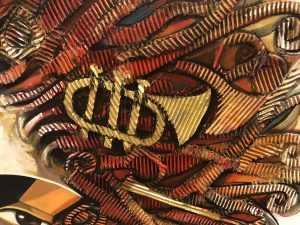
THE MUSICAL SISTER. A section
In spite of the aesthetically harmonious yet sharp expression shown in this sister, we find some elements that break the harmony, the many musical instruments we find in the hair. It looks as if they are randomly placed but we now know how precisely Haiti plans his work, so, just as the Impressionists created "apparently" random compositions in their expressions, the placement of the musical instruments is equally, "apparently," randomly placed in this expression.
The entire hair is created from corrugated cardboard, helping to create an embossed texture in the image.
Rings In Water II
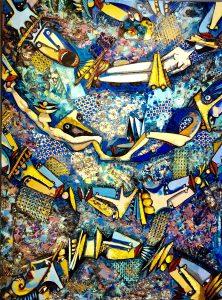
RINGER I VANN II (RINGS IN WATER II)
During my studio visit, I was also informed of the thinking behind the painting ”Rings in Water II”, which I had spent some time studying at the exhibition. It has previously been mentioned that Haiti is preoccupied with the interpersonal, easily linked to this painting. The artist himself says that he is very happy with the title ”Rings in Water” because there is something very poetic about the title. Metaphorically speaking, there is much to see here. Water may symbolize both purification and transition to something else. Not least, it is used in baptism within Christianity as a transitional ritual, symbolizing the person, whether child or adult, entering the Christian religion. The rings in the water can symbolize both unity and causality.
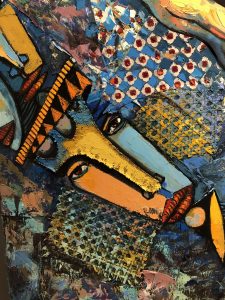
RINGS IN WATER II section. The skeptic , the philosopher?
The inspiration for this painting came from Michelangelo's Sistine Chapel in Rome and the Vigeland Park in Oslo. Since I had visited the Sistine Chapel a few days before the interview, fresh in mind was the memory of the masterpiece by Michelangelo who worked horizontally, high above the ground, for several years in order to recreate the Bible stories. Whilst the artist drew sacred inspiration from Michelangelo, he found profane expression in the sculptures in Vigeland Park. From this, Haiti created his very own version.
Ramon Haiti Filiu is concerned that his viewers should be able to recognize themselves in his art work, because then there exists a communication between the artwork and the viewer as well as between the artist and the viewer. Haiti and Kalgraff tell the story of a person who came to an exhibition and fell for a picture that was not one of the artist's favorites. The person bought the piece and only afterwards asked about the title, which was ”Supporting Me”. The person then told them that was exactly what was needed at a time when life was about fighting cancer.The couple can tell several such stories.
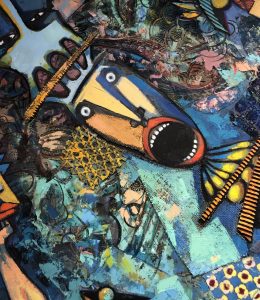
RINGS IN WATER II Is it the anxiety or some form of fear that has taken over?
In the painting ”Rings in water II”, the artist has introduced different types of people. We find the helper, who pulls the others with him to the middle of the picture and a little more to the left, the philosophical or skeptical if you will and not least, the face at the top left of the picture catches our eye, it seems that anxiety has taken over here.
Whatever one may have in one´s life baggage, most people will find some person that they can mirror in this picture. I found mine! Can you find yours?
I went back to the Wendelboe Art Gallery to chat with Egill Wendelboe Aarø and to discover why he has had several exhibitions of Ramon Haiti Filiu´s work. The answer was that Haiti´s art ”speaks” to him. In addition, Aarø added that Ramon is highly skilled in what he does. With that, the art dealer confirmed what many have already discovered, that Ramon Haiti´s art communicates with the viewer and has been created by a person who is skilled at his profession.
In 2017, Aarø connected the artist with sculptor Fredrik K.B. In a joint exhibition one sculpture by Fredrik K.B. was temporarily placed in the theater park. Given Haiti's background wherein his father, his most important teacher, was a sculptor, this was a good choice on the part of Egill Wendelboe Aarø. Here, in addition to the artistic collaboration, the artists themselves also communicated.
Art As Utility.
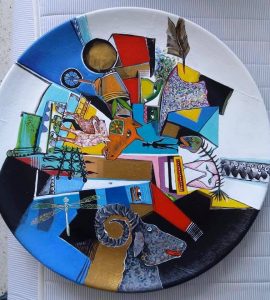
How about a decorative dish? Photo: Norunn Kalgraff
Given Ramon Haiti's background, having been raised by a mother who sewed costumes and a father who was a sculptor, it is no wonder that, even though the artist chose painting as his form of expression, it was natural that he should choose to create beautiful utility items as well. In recent years, therefore Haiti, in addition to creating paintings, has started to paint on bowls and saucers and not surprisingly, they are incredibly beautiful and aesthetic as is the rest of his art. Here too, nothing is left to chance, for in addition to the usual composition used in a painting, the shape of the object itself must be taken into account.
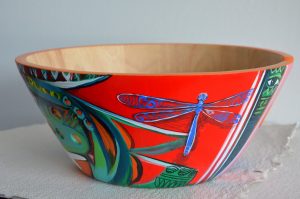
Or a knitting bowl? Photo: Norunn Kalgraff
Both the dishes and the knitting bowls have become very popular.
The mural Convergent
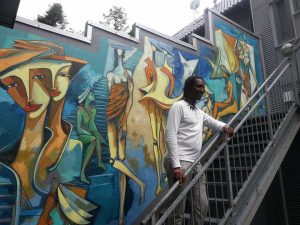
Ramon Haiti Filiu in front of the completed mural in Torggt. 12 in Bergen. Photo: Norunn Kalgraff
To be able to paint on a wall one must have some specialist knowledge. Just think of the ”Last Supper ” by Leonardo da Vinci, painted on a wall in the convent of Santa Maria delle Grazie in Milan. Over 500 years later, it is still in existence. That it has undergone some restoration is not in dispute but it is something that Haiti is surely aware of. Ramon Haiti probably also knows of the world famous Mexican fresco artist, Diego Rivera, who was married to Frida Kahlo. It is therefore natural to assume that the artist has the requisite knowledge when it comes to painting murals. Whether it is the fresco technique the artist has chosen to use, or not, is unknown but in the rainy city it is most likely to be so, as one must needs paint on wet walls. No matter what technique Haiti used, it is a beautiful, exciting sight that meets residents when they return to Vestre Torggt. 12 in Bergen.
The artist has had several assignments to decorate , not least at USF in connection with Night Jazz, but one also find traces of the artist if one visits Glesvær, outside Bergen. He painted ”The Course of Life” there in 2010.
In addition Haiti´s works have been purchased by Aleris Ungplan in Bergen, the Grieg Foundation in Bergen, Nordland Psychiatric hospital in Bodø, the University of Nordland in Bodø and several schools, so many people have become aware of Ramon Eduardo Haiti Filiu´s artwork.
Conclusion
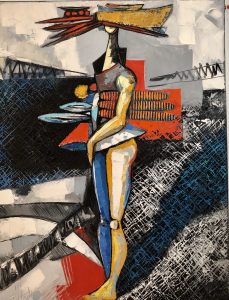
GRENSER BEGRENSER SINNET (BOUNDARIES LIMIT THE MIND)
Ramon Eduardo Haiti Filiu is an exciting, talented artist who is eminently educated and highly experienced. In the coldness of Norway, we need artists like Ramon who brings both color and warmth as well as wonderful artistic experiences to his viewers. There are many who have already experienced this art in his exhibitions, of which he has had many all over the country in the years he has been in Norway.
The artist is concerned with personal freedom, freedom from stereotypes and oppression. He praises the equality and cohesion that should characterize all people and, not least, he praises woman, the strong powerful female personality. Living in Norway is something he enjoys, even if the winter months are of the coldest type. When it is very cold he does what migratory birds do, he flies off to warmer climates. One thing the artist really appreciates is the selection of artistic materials that are to be found in Norway, and he thinks it is a pity that Norwegians no longer appreciate the opportunity to make use of them.
Attending an exhibition by Ramon Haiti is something to be recommended. As Norunn Kalgraff says, it affects people positively and they are different when they leave. This is due to the energy that arises when the images "talk" together. Even Haiti likes the images best when they are displayed in exhibitions, both in terms of the lighting and when the positive energy that Kalgraff refers to, arises. That the energy is good, there is no doubt.
Now, having focused on the art of Ramon Eduardo Haiti Filiu, the undersigned has become a richer human being and his painting ”Borders Limits Minds” may be food for thought for anyone and everyone.
Thanks to Ramon Eduardo Haiti Filiu who gives us, as viewers, so much fine art to experience and for his excellent conversation.
A special thank you to Norunn Kalgraff for her cooperation during this process, and also thanks to Willy Rasmussen who, in addition to being my interpreter during the studio visit, has promised to guide me further in my understanding of Santeria.
Last but not least, thanks a lot to Jim Gordon for his translation into English.
You may follow Ramon Haiti Filiu on Facebook.
Photos where the photographer is not designated have normally been taken by the undersigned.
Author: Wenche Holmedal
Art historian and educator
Responsible for Samtidskunst.com
